 |

Botanical Society of the British Isles
Field Meeting in the Castilian Páramos
led by Teresa Farino and Jon Cox
13 - 20 May 2009
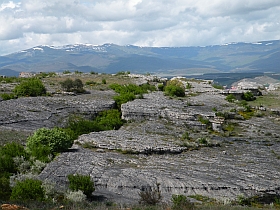 Las Tuerces © Teresa Farino
Thirteen BSBI members joined leaders Teresa Farino and Jon Cox for a week to explore this relatively unknown area of northern Spain, which straddles the confluence of the provinces of Palencia (P), Burgos (Bu) and Cantabria (S). After driving up from Madrid, we spent the next six days investigating the flora of the high limestone plateaux of the region - known as páramos - where the 'bones' of the land protrude through the thin soils, creating a charismatic landscape of crags and buttresses, interspersed with low-intensity cereal cultivations, species-rich grasslands and fragments of evergreen oak forest. We also visited more montane habitats - both on limestone and siliceous bedrock - in the Cordillera Cantábrica to the north, as well as the impressive river canyon carved out by the infant Ebro. Las Tuerces © Teresa Farino
Thirteen BSBI members joined leaders Teresa Farino and Jon Cox for a week to explore this relatively unknown area of northern Spain, which straddles the confluence of the provinces of Palencia (P), Burgos (Bu) and Cantabria (S). After driving up from Madrid, we spent the next six days investigating the flora of the high limestone plateaux of the region - known as páramos - where the 'bones' of the land protrude through the thin soils, creating a charismatic landscape of crags and buttresses, interspersed with low-intensity cereal cultivations, species-rich grasslands and fragments of evergreen oak forest. We also visited more montane habitats - both on limestone and siliceous bedrock - in the Cordillera Cantábrica to the north, as well as the impressive river canyon carved out by the infant Ebro.
Mid-May normally sees the cereal fields of the páramos teeming with arable weeds, but we found the season to be abnormally late, following one of the hardest winters in recent years. All agreed, however, that despite the lack of colourful displays of poppies and cornflowers, there was more than enough of botanical interest to keep us on our toes.
The taxonomy used in the following report follows Flora Iberica as far as possible. Teresa and Jon would like to extend their heartfelt thanks to Lynne Farrell, who assumed the not inconsiderable task of collating each day's findings in the evenings, resulting in a total species list for the week of almost 600 taxa.
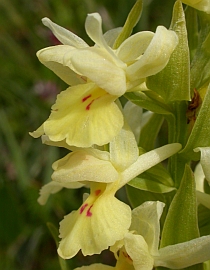 Barton's Orchid
Barton's Orchid
Dactylorhiza insularis
© Teresa Farino
13 May 2009 - Hoyos del Tozo (Bu)
Having managed to collect everyone from the new Terminal 4 at Madrid airport (interesting architecture!) without too many problems, and then driven up the A1 to Burgos, we found we just had time for an hour's botanising on a dry limestone plateau and small canyon near Hoyos del Tozo, on the southern margin of the Páramo de La Lora.
In what was to become the pattern for the week, no sooner had the minibuses ground to a halt than botanists fanned out in all directions, in search of suitable habitat for their favourite plant groups. Those of us who stayed fairly close to the vehicles in the first instance found a wealth of orchids - many of which were of inordinately small stature following the hard winter - including Orchis morio (= Anacamptis morio; Green-winged Orchid), Aceras anthropophorum (= Orchis anthropophora; Man Orchid), Dactylorhiza insularis (Barton's Orchid), Ophrys tenthredinifera (Sawfly Ophrys), Ophrys lutea (Yellow Ophrys) and Ophrys sphegodes (Early Spider-orchid).
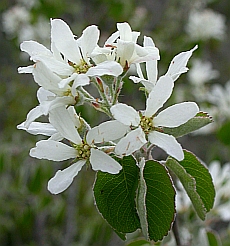 Snowy Mespilus
Snowy Mespilus
Amelanchier ovalis
© Teresa Farino
Among the other monocots growing here were stately Asphodelus albus and A. aestivus (White and Common Asphodels), Aphyllanthes monspeliensis (Blue Aphyllanthes) and Muscari comosum (Tassel Hyacinth). The low-growing, white-flowered Spiraea hypericifolia subsp. obovata was the predominant shrub on the plateau, in the shelter of which grew a number of scarce British species, notably Viola kitaibeliana (Dwarf Pansy), Trinia glauca (Honewort) and Carex humilis (Dwarf Sedge). Incredibly, some attempt had been made to cultivate cereals on the exceedingly thin soils of the plateau, with these more disturbed areas turning up the shepherd's-needle Scandix australis, Asterolinon linum-stellatum (Asterolinon) and Neatostema apulum (Yellow Gromwell).
A little further east we explored the first section of a small limestone gorge, whose sides were decorated with clumps of Amelanchier ovalis (Snowy Mespilus) in full flower, among which flourished the eye-catching Thalictrum tuberosum, with creamy flowers up to 4cm in diameter, Hornungia petraea (Hutchinsia), the fleshy-leaved Saxifraga cuneata and Globularia vulgaris (Common Globularia).
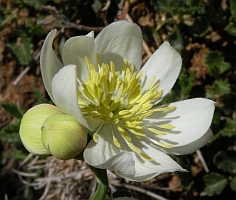 Thalictrum tuberosum
© Teresa Farino
Thalictrum tuberosum
© Teresa Farino
Such was the enthusiasm engendered by this first taste of the páramos that it took quite some time to round everyone up to drive the final few kilometres to our hotel in the converted convent of Santa María de Mave, but eventually we were able to sit down to our first delicious evening meal of the week.
14 May 2009 - Las Tuerces (P)
Our first full day in the field dawned fair, but with a brisk north-easterly wind that made some of us wish that we were more warmly dressed before the end of the day. We drove just a short distance from the hotel before parking the vehicles by the Río Pisuerga at the foot of the limestone 'sculpture city' of Las Tuerces, where Leslie gave us a succinct introduction to the willows growing along the margins, for the most part Salix atrocinerea, Salix fragilis (Crack Willow) and S. purpurea (Purple Willow). Cetti's Warblers and Nightingales sang from the depths of this marginal vegetation, while the river itself sported lush ribbons of Ranunculus penicillatus (Stream Water-Crowfoot).
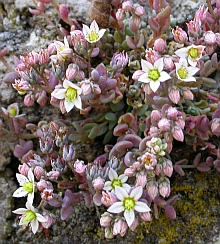 Thick-leaved Stonecrop
Thick-leaved Stonecrop
Sedum dasyphyllum
© Teresa Farino
We spent much of the morning strolling through the village of Villaescusa de las Torres, where the dry-stone walls were festooned with Sedum dasyphyllum (Thick-leaved Stonecrop), Telephium imperati, Saxifraga tridactylites (Rue-leaved Saxifrage), Chaenorhinum origanifolium (Malling Toadflax) and Campanula erinus (Annual Bellflower). The more natural rock-gardens, by contrast, were a gloriously colourful melange of yellow-flowered Stachys recta (Perennial Yellow Woundwort), the Iberian endemic toadflax Linaria badalii and the composite Pallenis spinosa; blue Echium vulgare (Viper's-bugloss) and Linum narbonense (Beautiful Flax); and white Marrubium vulgare (White Horehound) and the star-of-Bethlehem Ornithogalum narbonense.
The dominant shrubs here were the horribly spiny Genista scorpius, plus Amelanchier ovalis and Jasminum fruticans (Wild Jasmine), while more temporary habitats along the margins of the track hosted annuals such as Papaver argemone (Prickly Poppy), Silene conica (Sand Catchfly), Petrorhagia prolifera (Proliferous Pink), Euphorbia serrata, Scandix pecten-veneris (Shepherd's-needle), Anchusa arvensis (Bugloss) and Centranthus calcitrapae (Annual Valerian). Those of the group who were investigating a parallel route along the crest of the adjacent limestone ridge were rewarded with a brief glimpse of a small Snub-nosed, or Lataste's, Viper, as well as that rare British umbellifer Bupleurum baldense (Small Hare's-ear).
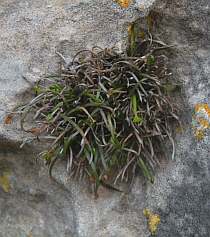 Asplenium seelosii ssp. glabrum
© Teresa Farino
Asplenium seelosii ssp. glabrum
© Teresa Farino
We picnicked at a junction of tracks by a small stream, after which we spent the afternoon exploring the labyrinth of limestone pillars and buttresses on the summit of Las Tuerces. Foremost in our thoughts was to track down the curious little fern Asplenium seelosii subsp. glabrum, a rather scarce species in Spain, for which Teresa had found an old record from the area, despite it not being listed as present in Palencia in Flora Iberica. Following much minute examination of a number of limestone outcrops, Martin eventually struck gold, and we went on to discover at least seven clumps of the plant growing in shady nooks on the north-facing exposures of several outcrops.
Other plants of interest on the wind-swept upper reaches of Las Tuerces included Ranunculus gramineus and R. paludosus (Grass-leaved and Jersey Buttercups), silvery-leaved Plantago monosperma subsp. discolor, Valeriana tuberosa, with small, pink heads, the montane cornflower Centaurea triumfetti, the viper's-grass Scorzonera hispanica, with conspicuous yellow flowers, the Afro-Iberian endemic Poa ligulata and Ophrys fusca (Dull Ophrys), as well as drifts of diminutive Muscari neglectum (Common Grape-hyacinth) and Tulipa sylvestris subsp. australis (Wild Tulip), the latter unfortunately past their best. Scattered copses of Quercus faginea (Lusitanian Oak) dotted the plateau, with damp areas on seepage-lines harbouring Schoenus nigricans (Black Bog-rush) and Adiantum capillus-veneris (Maidenhair Fern).
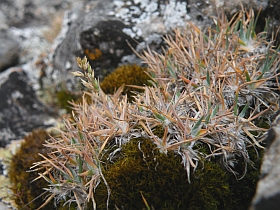 Poa ligulata
© Teresa Farino
Poa ligulata
© Teresa Farino
15 May 2009 - Fontibre and Alto Campóo (S)
For a complete change of scenery, today we headed north towards the valley of Alto Campóo, which runs westwards from Reinosa towards the peak of Tres Mares. We stopped briefly at Fontibre to pay our respects to the 'official' source of the Río Ebro, from which the Iberian peninsula gets its name, although there is actually a longer tributary - the Río Híjar - that rises some 18km further west, on the flanks of Pico Tres Mares.
Despite being essentially a poplar plantation, Fontibre sports a rather rich ground flora, comprising a luxuriant growth of shade-tolerant Ophioglossum vulgatum (Adder's-tongue), Helleborus foetidus (Green Hellebore), Saxifraga granulata (Meadow Saxifrage), Cruciata laevipes (Crosswort) and many other woodland species familiar from the UK. Brighter splashes of colour announced the presence of purplish Pulmonaria longifolia (Narrow-leaved Lungwort) and yellow Symphytum tuberosum (Tuberous Comfrey). Curiously, both Polystichum aculeatum and P. setiferum were growing here, in close proximity.
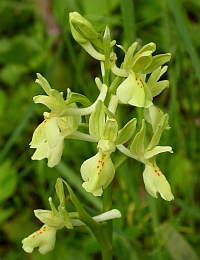 Provence Orchid
Provence Orchid
Orchis provincialis
© Teresa Farino
More interesting, however, for most members of the group, were the splendid specimens of Orchis pallens (Pale-flowered Orchid) and O. provincialis (Provence Orchid) that we found here: the former with broad, unspotted leaves and robust spikes of lemon-yellow flowers, and the latter with short, relatively few-flowered spikes of delicate, long-spurred flowers, the lip of each speckled with orange. We also came across an occasional spike of Orchis purpurea (Lady Orchid) and O. mascula (Early Purple Orchid), as well as what we deduced to be a hybrid between O. pallens and O. mascula, its reddish-pink flowers sporting broad, rounded and unspotted lips. Some well-grown plants of Polygonatum multiflorum (Solomon's-seal), clumps of pale-blue Scilla verna (Spring Squill) and a sheet of Fritillaria pyrenaica (Pyrenean Snakeshead), the flowers sadly well past their best, completed the list of monocots we found here.
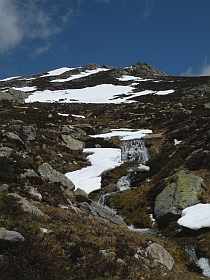 Alto Campóo, above Brañavieja
© Teresa Farino
Alto Campóo, above Brañavieja
© Teresa Farino
Teresa confessed to some anxiety as to what we would find further up the valley, above the Alto Campóo ski station (Brañavieja), because snowfalls had been heavy and lingering. However, the sun shone, Water Pipits, Wheatears and Skylarks filled the air with song, and snowmelt-fed streams cascaded over the igneous rocks and peaty soils, revealing the first flushes of a flora quite different to that of the limestone we visited most other days. The short turf was studded with the nodding pink-purple heads of Erythronium dens-canis (Dog's-tooth-violet) and drifts of the smallest of all trumpet daffodils, Narcissus jacetanus subsp. vasconicus, identified by their straight cylindrical trumpets and thin, transparent or browning, spathes, as well as a few of the smallest hoop-petticoat daffodil: N. bulbocodium subsp. nivalis. Leslie pointed out that, like many montane species, these narcissi have the simplest genetic makeup, both being diploids.
Here too we came across some of the most splendidly floriferous clumps of Spring Gentian (Gentiana verna) that most of us had ever seen, as well as Thlaspi caerulescens (Alpine Penny-cress), Pinguicula grandiflora (Large-flowered Butterwort), Ajuga pyramidalis (Pyramidal Bugle), Cruciata glabra and a species of Gagea. Several pteridophytes were seen only here during the week, notably Selaginella selaginoides (Lesser Clubmoss) Cryptogramma crispa (Parsley Fern), Dryopteris oreades (Mountain Male-fern) and, curiously, given the granite bedrock, Polystichum lonchitis (Holly-fern).
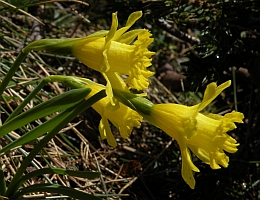 Narcissus jacetanus ssp. vasconicus
© Teresa Farino
Narcissus jacetanus ssp. vasconicus
© Teresa Farino
A little further down the valley we paused to examine the head-high scrub of pink-flowered Erica australis (Spanish Heath; in full bloom), white-flowered E. arborea (Tree Heath; still in bud) and the greenweed Genista obtusiramea, endemic to north-western Iberia, among which were growing less lofty shrublets such as Erica vagans (Cornish Heath), Calluna vulgaris (Ling), Pterospartum tridentatum, with undulate, toothed wings on the stems, and Genista anglica (Petty Whin). A second stop at the Mirador de la Joyanca turned up some delightful Narcissus triandrus (Angel's-tears), as well as the eye-catching Daboecia cantabrica (St Dabeoc's Heath) and several white-flowered species: Anemone nemorosa (Wood Anemone), Moenchia erecta (Upright Chickweed), Arenaria montana (Large-flowered Sandwort) and Potentilla montana, whose leaves are toothed only at the tip.
We took a different route back towards Santa María de Mave, stopping at an area of wet, acid pastures to the north of Salcedillo. These were dominated by Nardus stricta (Mat-grass), with colour provided by pink and purple Lathyrus linifolius (Bitter-vetch), Vicia orobus (Upright Vetch), (Pedicularis sylvatica (Lousewort), Dactylorhiza maculata (Heath Spotted-orchid) and some lovely pale-rose-tinted Orchis morio, plus yellow Pedicularis schizocalyx (an Iberian endemic), Scorzonera humilis (Viper's-grass), Dactylorhiza sambucina var. lutea (Elder-flowered Orchid) and Narcissus bulbocodium subsp. bulbocodium.
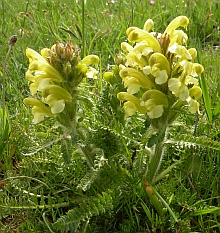 Pedicularis schizocalyx
© Teresa Farino
Pedicularis schizocalyx
© Teresa Farino
There was just enough time remaining at the end of the day for a quick visit to the Romanesque collegiate church at Cervatos, which is renowned for the 'erotic' gargoyles that decorate the eaves. Those of us who had binoculars or zoom lenses on our cameras were able to examine these in some detail, and were frankly amazed that such graphic sculptures should adorn a place of worship!
16 May 2009 - Páramo de la Lora (Bu & S)
Although the day started with heavy cloud, it steadily improved to become sunny and warm, but was very windy throughout. Teresa had set up a moth trap the previous evening in the grounds of the hotel, which a few of us examined before breakfast; the most notable species were a Small Elephant Hawk-moth (Deilephila porcellus) and a Spanish Tiger (Hyphoraia dejeani), the latter unique to the Iberian peninsula.
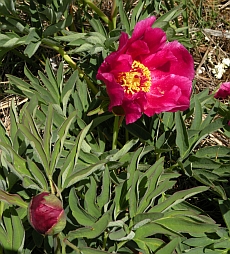 Paeonia officinalis ssp. microcarpa
© Teresa Farino
Paeonia officinalis ssp. microcarpa
© Teresa Farino
We set off to the east, taking the Burgos road for a short way then turning north at Basconcillos del Tozo, stopping after a few kilometres on a grassy hillside amongst limestone outcrops. Here we found striking clumps of Adonis vernalis (Yellow Pheasant's-eye), whose large golden flowers contrasted well with its dark green foliage, and the lovely scarlet peony Paeonia officinalis ssp. microcarpa. Orchids were abundant, in particular Orchis purpurea, O. mascula, O. morio and Aceras anthropophorum, plus Ophrys lutea, O. fusca and O. sphegodes.
Along the edges of the cereal fields here we encountered a number of attractive 'weeds', notably Ranunculus arvensis (Corn Buttercup), with its 'spiny' carpels, the Iberian endemic mignonette Reseda barrelieri, Androsace maxima (Annual Androsace) and Asperula arvensis (Blue woodruff). Black Kites were seen soaring overhead, while a multitude of Painted Ladies (Vanessa cardui) were nectaring on the abundant flowers; perhaps some of the latter were among the many thousands to reach the British Isles this year.
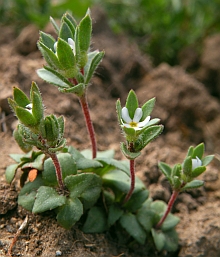 Annual Androsace
Annual Androsace
Androsace maxima
© Teresa Farino
Moving on to the village of Sargentes de la Lora, we turned north along dusty tracks and parked on a fairly level plateau at a little over 1,000 metres: the Páramo de la Lora. The surrounding landscape of slabs of baked limestone with scattered rocky outcrops appeared to be almost devoid of vegetation, punctuated only by, a few small clumps of Quercus ilex subsp. ballota (Western Holm Oak) and some diffident attempts at human cultivation of the thin soils.
Almost immediately Paul spotted a spectacular red, white and black moth - Eucharia festiva - with a wingspan of some 7cm, which did its best to avoid our attempts at photography as it crawled across the sward. Other interesting invertebrates included both male and female Striped Oil Beetles (Berberomeloë majalis), also resplendent in black and red livery, as well as Field Crickets (Gryllus campestris), a mating pair of Narrow-bordered Bee Hawkmoths (Hemaris tityus) and several chubby black and orange Apollo (Parnassius apollo) caterpillars. Among the many butterflies we spotted were Swallowtails (Papilio machaon), Spanish Swallowtails (Iphiclides feisthamelii), Peacocks (Inachis io) and Clouded Yellows (Colias crocea).
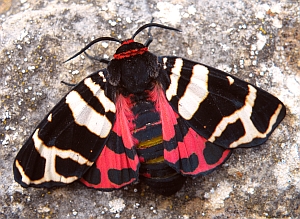 Eucharia festiva
© Teresa Farino
Eucharia festiva
© Teresa Farino
There was little vegetation above knee height, with the predominant woody species being Juniperus communis (Common Juniper), Spiraea hypericifolia subsp. obovata, Genista hispanicus subsp. occidentalis (Spanish Gorse) and G. scorpius. Sheets of yellow Ranunculus gramineus were accompanied by the intense blue of Linum narbonense, the pinks of the Spanish endemic stork's bill Erodium daucoides and the diminutive Parentucellia latifolia (Southern Red Bartsia), punctuated by white candytuft Iberis saxatilis. Wherever there was enough soil to sustain them, there were dense drifts of orchids, principally the Orchis and Ophrys species seen earlier, but with the addition of Neotinea maculata (Dense-flowered orchid), and the yellow Dactylorhiza insularis.
Lunch was taken atop a small limestone cliff, at the base of which grew an abundance of Asplenium trichomanes (Maidenhair Spleenwort) and A. ruta-muraria (Wall-rue), plus a huge colony of Cystopteris fragilis (Brittle Bladder-fern). After the customary splendid lunch, some members of the group descended a shallow valley to a small stream where the moister conditions favoured a flora a little more familiar to us from the north of Europe. Here we encountered Carex paniculata (Greater Tussock-sedge) and C. lepidocarpa (= C. viridula subsp. brachyrrhyncha; Long-stalked Yellow-Sedge), as well as lemon-yellow Tetragonolobus maritimus (Dragon's-teeth) and a solitary spike of Listera ovata (= Neottia ovata; Twayblade). Others continued to explore the more barren tablelands, where Sophie spotted a fabulous lime-coloured Western Green Lizard (Lacerta bilineata) in a pile of rocks.
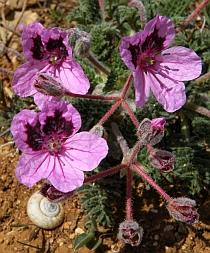 Erodium daucoides
© Teresa Farino
Erodium daucoides
© Teresa Farino
Turning 'homewards', we passed through the village of Sargentes into an intensely green valley, with enough water for the local people to have achieved a good standard of arable cultivation. At its head was a spring of clear water, around which we found the very attractive crucifer Sisymbrella aspera subsp. aspera, Mentha pulegium (Pennyroyal), Senecio aquaticus (Marsh Ragwort) and a lemon yellow hoop petticoat daffodil, which Leslie declared to be the tetraploid Narcissus bulbocodium subsp. citrinus. Nearby was one of the many Neolithic dolmens of La Lora, its central chamber lined with huge vertical slabs of stone; these laborious constructions are thought to have been of great religious or ritual significance to the people of that time.
17 May 2009 - Puerto de Piedrasluengas (P)
Sunday saw us heading back towards the mountains, this time to the limestone-dominated pass of Piedrasluengas (1,355m) that lies between the Picos de Europa and the Sierra de Peña Labra. Emerging from Quercus pyrenaica (Pyrenean Oak) woodlands in the lower Pisuerga valley we headed up into the stream-side meadows just below the pass, where we soon spotted the spectacular Narcissus pseudonarcissus among the cowslips and made our first stop. Here we were able to enjoy these huge daffodils at close quarters and indulge in a little Narcissus-based taxonomic controversy (were they in fact subsp. leonensis or nobilis?) amongst the vivid splashes of Euphorbia hyberna (Irish Spurge). Along the stream Cardamine raphanifolia (Greater Cuckooflower) enlivened the lushness, and Trollius europaeus (Globeflowers) and Dactylorhiza incarnata (Early Marsh Orchids) were just coming into bloom. All this made a vivid contrast to the steep slopes immediately above, which were dominated by a tall scrub of Erica arborea, E. vagans, Genista florida and G. obtusiramea.
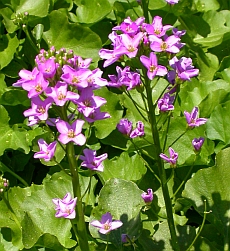 Greater Cuckooflower
Greater Cuckooflower
Cardamine raphanifolia
© Teresa Farino
A short journey onward brought us to the mirador at the head of the pass where we were able to enjoy the views into the Picos, surrounded by beechwoods and the sort of limestone crags an early Romantic might have described, with rather different intent, as "awful" and "horrid". Soon we were hopping from crag to crag in search of alpine delights, but the lateness of the season was evident, even on the southerly exposures. The northern Spanish endemic Saxifraga canaliculata was everywhere, but barely in bud, while the lime-encrusting Saxifraga paniculata (Livelong Saxifrage) had to rely on its undoubted vegetative appeal. However, Anemone pavoniana was flowering very prettily on the cliffs and there were bright splashes of yellow from the crucifer Erysimum duriaei; both species are unique to the Cordillera Cantábrica. More local endemic crucifers in flower were the dainty Pritzelago (= Hutchinsia) alpina subsp. auerswaldii, growing alongside 'pincushions' of Draba dedeana, and we were also delighted with the Iberian endemic grass Oreochloa confusa, distinguished by its neat, two-ranked spikes.
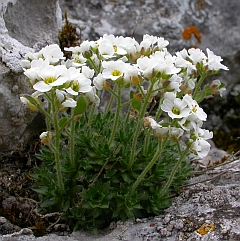 Draba dedeana
© Teresa Farino
Draba dedeana
© Teresa Farino
More widespread montane plants in bloom included sheets of Potentilla crantzii (Alpine Cinquefoil), Ribes alpinum (Mountain Currant), the delicate pink-and-white Potentilla micrantha, Astragalus depressus (Sprawling Milk-vetch), and a scattering of Gentiana verna. Acinos alpinus (Alpine Calamint) and Chaenorhinum origanifolium looked good together on the rocks, and several early spikes of Himantoglossum hircinum (Lizard Orchid) were present on one sunny slope. The very different Juniperus communis subsp. nana (Dwarf Juniper) and J. sabina (Savin) growing side by side surprised some who were not familiar with them.
We made our way down again through a little marsh where Catabrosa aquatica (Water Whorl-grass) was already flowering, passing over at least three Alchemilla species in fear and loathing. As we descended to the road, the banks around the Narcissus fields were seen to be full of the deep-purple Viola bubanii (Violet Mountain Pansy), yet another northern Spanish endemic. By now a sharp cold breeze was blowing up the pass, and the next half hour resembled an undergraduate stunt as 15 botanists tried to occupy an enclosed bus shelter alongside two tables full of Teresa's notorious lunch provisions.
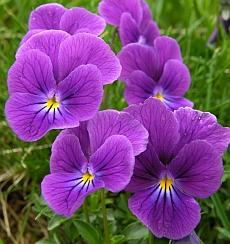 Violet Mountain Pansy Viola bubanii
© Teresa Farino
Violet Mountain Pansy Viola bubanii
© Teresa Farino
Despite the exciting novelties of the morning, the highlight of the day for many of us was the afternoon's walk through a small valley to the south of the pass: a little Arcadia of stream, meadow and beechwood. In damper spots Trollius europaeus was joined by flowering Ranunculus aconitifolius (Aconite-leaved Buttercup) and Geum rivale (Water Avens), with Geranium sylvaticum (Wood Crane's-bill) and Crepis paludosa (Marsh Hawk's-beard) as yet to flower. On one crag, Arabis scabra (Bristol Rock-cress) could be admired, while butterflies of note in this sheltered valley included Duke of Burgundy Fritillary (Hamearis lucina) and Queen of Spain Fritillary (Issoria lathonia).
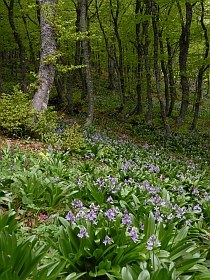 Beechwoods with Scilla
Beechwoods with Scilla
lilio-hyacinthus at Piedrasluengas
© Teresa Farino
The beechwoods were carpeted with flowering Scilla lilio-hyacinthus (Pyrenean Squill), making a fair imitation of an English bluebell wood, but dotted through with Hepatica nobilis (Hepatica), Aquilegia vulgaris (Columbine), Corydalis cava (Hollow-root), Cardamine impatiens (Narrow-leaved Bitter-cress), Primula elatior (Oxlip), and Erythronium dens-canis. In the woodland glades, the leaves of Adenostyles alliariae (Adenostyles), Lilium martagon (Martagon Lily) and Paris quadrifolia (Herb-Paris) gave promise of things to come, as did the sheets of glaucous-leaved Allium scorzonerifolium (= A. stramineum) in the adjacent meadow. It was with horror, therefore, that we learned that the road here was due to be straightened and widenened, almost certainly resulting in the destruction of this beautiful spot, and all in the interest of speeding up, and probably increasing, traffic between the central plains and the coast.
Rejoining the vans by a site for Aconitum lamarckii, the Iberian endemic Ranunculus gouanii (Gouan's Buttercup) and Fly Honeysuckle (Lonicera xylosteum), where we were also able to admire the enormous leaves of the hogweed Heracleum sphondylium subsp. pyrenaicum, we set off for the Romanesque church of San Salvador de Cantamuda. This was expected to be a strictly cultural stop, but turned up one of the real botanical surprises of the week: Dryopteris submontana (Rigid Buckler-fern) growing on the north wall of the building.
Our final stop, in a glorious clear evening light, with limestone ridges ringing the horizon and the peace broken only by Nightingales singing seemingly from every bush, was at another little Romanesque chapel near Barrio de Santa María: a village dubbed 'Stork City' because of the enormous number of nesting White Storks, encouraged by nesting platforms almost as thick on the ground as the Castilian wind turbines. As some of the group admired the intricately carved capitals of the chapel, others examined the crop of ruderal and arable weeds in the surrounding cereals, to be rewarded by a scarlet-flowered pheasant's-eye - either Adonis flammea or A. aestivalis subsp. squarrosus, in the absence of ripe fruits - as well as Thlaspi perfoliatum (Perfoliate Penny-cress) and Centaurea cyanus (Cornflower), while the spot where we had parked our vans turned up a new grass for the week, suspected by Arthur to be Hordeum hystrix.
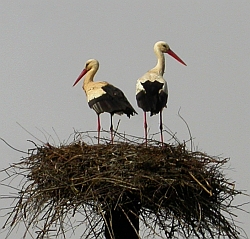 White Storks
White Storks
Ciconia ciconia
© Teresa Farino
18 May 2009 - Hoces del Ebro (Bu)
This was probably the longest field day in the whole trip, involving an 11km walk through the Hoces del Ebro: a spectacular limestone gorge carved out by the powerful infant river of that name. Stuart Hedley (Teresa's co-leader from our Benasque tour in 2008) and Graeme Deas also spent the day with us, providing extra expertise in identification.
While Teresa and Jon refuelled the vehicles, the group spent a profitable half hour or so exploring a small area of acid heathland near Respenda de Aguilar (P), where Green Hairstreaks (Callophrys rubi) was seen nectaring on the flowers, and a male Hen Harrier flew overhead. The heath was dominated by the beautiful Erica umbellata, with its distinctive, upwards-pointing, urn-shaped flowers, bushes of Lavandula stoechas (French Lavender) that released a wonderful aroma as we walked, and the white-flowered 'sun-rose' Halimium umbellatum. Arthur informed us that among the more interesting grasses here were Mibora minima (Early Sand-grass), Micropyrum tenellum (Gravel Fescue), Vulpia unilateralis and Aira elegantissima. As well as the rare British species Veronica triphyllos (Fingered Speedwell), we also found the skull of a large canine by the roadside and speculated as to whether it could have been that of a Wolf, as this part of Spain is known to harbour a healthy population of these carnivores.
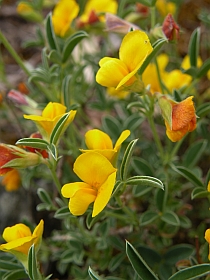 Argyrolobium zanonii
© Teresa Farino
Argyrolobium zanonii
© Teresa Farino
As we drove towards the Hoces we passed innumerable limestone outcrops, sadly often topped by unsightly wind farms, before stopping in the dry Mediterranean scrub above the Ebro gorge for elevenses. Here we saw at least three species of juniper Juniperus communis, J. phoenicea (Phoenician Juniper) and J. oxycedrus (Prickly Juniper), but more eye-catching were the low clumps of yellow-flowered, silvery-leaved Argyrolobium zanonii, Leuzea conifera (Cone Knapweed) and Allium roseum (Rosy Garlic). Butterflies on the wing included Red-underwing Skipper (Spialia sertorius) and Adonis Blue (Lysandra bellargus).
When we eventually arrived at the village of Pesquera de Ebro we saw a Short-toed Treecreeper climbing up a tree trunk in front of the church as we were parking. The Medieval bridge just below the village was festooned with the pale-yellow snapdragon Antirrhinum braun-blanquetii, and provided us with views of a Dipper below and Swifts overhead. Back at the church we began the main walk of the day, first through open fields full of botanical (and zoological) temptations, including magnificent stands of the delicate Silene nutans (Nottingham Catchfly), Coronilla scorpioides (Annual Scorpion-vetch), the umbellifer Laserpitium eliasii, Scrophularia canina (French Figwort), the shrubby plantain Plantago sempervirens, the distinctive grass Aegilops geniculatus and Ophrys scolopax (Woodcock Ophrys). Insects attracted by this multitude of flowers included Cleopatra (Gonepteryx cleopatra), Knapweed Fritillary (Melitaea phoebe) and Spanish Swallowtail butterflies and a Mother Shipton (Callistege mi) moth, while a handsome Red-backed Shrike perched obligingly on a nearby branch for us to admire.
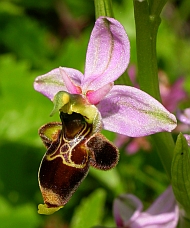 Woodcock Ophrys
Woodcock Ophrys
Ophrys scolopax
© Teresa Farino
Dragging ourselves away from the fields we finally reached the Ebro itself, where some quite substantial patches of Lathraea clandestina (Purple Toothwort) were seen parasitizing the roots of some of the Populus nigra (Black Poplar) trees. Although the other dominant canopy species of this riverine forest was Fraxinus angustifolia (Narrow-leaved Ash), the shrub layer and ground flora on the whole appeared to be similar to that of an English woodland, albeit belied by the abundance of scarce British species such as Buglossoides purpurocaerulea (Purple Gromwell), Melittis melissophyllum (Bastard Balm) and Scirpoides holoschoenus (Round-headed Club-rush), and firmly disproven by clumps of Petrocoptis pyrenaica ssp. glaucifolia (Blue-leaved Petrocoptis) and Sarcocapnos enneaphylla on a shady crag. Firecrests, Long-tailed Tits and Iberian Chiffchaffs darted about in the canopy, and Iberian Water Frogs chorused from the river margins.
Eventually the shady deciduous forest gave way to more open, Mediterranean vegetation, and from a delightful lunch spot, surrounded by pink cushions of Saponaria ocymoides (Rock Soapwort) and yellow Helichrysum stoechas, and with a pair of Egyptian Vultures circling overhead, we were able to make a side excursion to see Fumana ericoides, Ajuga chamaepitys (Ground-pine), Orobanche gracilis (Slender Broomrape) and Limodorum abortivum (Violet Limodore), some of which displayed this rather pinkish coloration.
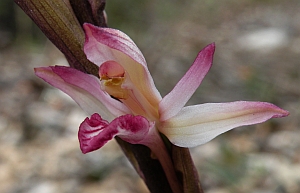 Violet Limodore
Violet Limodore
Limodorum abortivum
© Teresa Farino
After lunch, some members of the group retraced their steps with Jon whilst the others continued on through the gorge with Teresa, although the narrowness of the path and considerable botanical interest meant that we were probably spread over half a kilometre by the time we reached the end! Teresa examined every single specimen of Limodorum she encountered en route, in the hopes of locating the L. trabutianum (Trabut's Limodore) she had found here in the past, but sadly none had the very short spur typical of the species. We did, however, encounter many other botanical gems along the way, including Equisetum variegatum (Variegated Horsetail), the birthwort Aristolochia paucinervis, the silver-hairy mercury Mercurialis tomentosa, Arabis turrita (Tower-cress), Cistus salviifolius (Sage-leaved Cistus), Sorbus domestica (True Service-tree), the linear-leaved, salmon-pink-flowered Lathyrus cicera and much larger, pink-flowered Lathyrus latifolius (Broad-leaved Everlasting-pea) and Cephalanthera rubra (Red Helleborine) in bud.
We marvelled at butterflies such as Berger's Clouded Yellow (Colias alfacariensis), Provence Orange Tip (Anthocharis euphenoides) and Green-underside Blue (Glaucopsyche alexis), none of which is found in Britain, as well as at some fabulous Beautiful Demoiselle damselflies (Calopteryx virgo meridionalis), the males of which have vivid blue wings, while the females are bronze-coloured. A Western Three-toed Skink (Chalcides striatus) and several Iberian Wall Lizards (Podarcis hispanica) were also observed, while Sue spotted another Western Green Lizard, although it was rather camera-shy, and refused to emerge from under a large rock to have its picture taken properly.
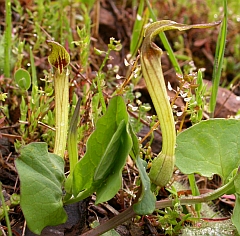 Aristolochia paucinervis
© Teresa Farino
Aristolochia paucinervis
© Teresa Farino
19 May 2009 - Olleros de Pisuerga (P) and Peña Amaya (Bu)
It was to be a day of variety, our last in the páramos of Northern Castile. First, by popular vote, we took up Teresa's option of visiting the local market in Aguilar de Campóo, joining the influx of local inhabitants already making their way into the market square, where stall-holders were at work setting out their wares. Among the busiest of the stalls was one selling small plants, which people were taking home to their own vegetable plots to cultivate: a nice reminder of the priorities of people living in this part of rural Spain.
Lynne, by contrast, spent some of the morning delving into the depths of the Río Pisuerga, turning up Groenlandia densa (Opposite-leaved Pondweed), while Arthur and Gerard rummaged along the banks, producing Carex acuta (Slender Tufted-sedge), C. acutiformis (Lesser Pond-sedge) and C. riparia (Greater Pond-sedge).
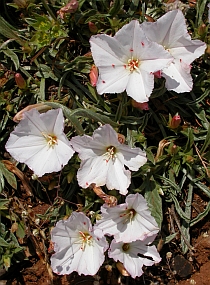 Convolvulus lineatus
© Teresa Farino
Convolvulus lineatus
© Teresa Farino
On leaving the market, we turned back towards Mave, our first stop being at Olleros de Pisuerga, where we had previously spotted some hay-meadow-like grasslands. The most productive field supported a good population of Rhinanthus minor (Yellow-rattle) - the botanists' friend - which had successfully reduced the vigour of the grasses, enabling other less competitive plants to gain a foothold. As a result, we located Lathyrus aphaca (Yellow Vetchling), Malva moschata (Musk Mallow), a healthy population of Carex divisa (Divided Sedge), which is exceedingly rare in the UK, and the star-of-Bethlehem Ornithogalum orthophyllum. John also found Equisetum ramosissimum (Branched Horsetail) here; another exceptionally scarce British species, although its status as a native plant in the UK is doubtful.
We then tried to visit the renowned 6th-century 'cave church' here, but unfortunately, the caretaker had broken her leg and was unable to give us access. The bare hillside below the entrance was heavily grazed so new records were scare, but we did find Paronychia polygonifolia and Convolvulus lineatus, and Arthur collected a species of Agrostis that he'd never seen before. Our walk back towards Mave was enlivened by the blues and reds of Papaver rhoeas (Common Poppies) and Centaurea cyanus along the roadside verges, the latter attracting butterflies such as Glanville Fritillary (Melitaea cinxia) and Black-eyed Blue (Glaucopsyche melanops).
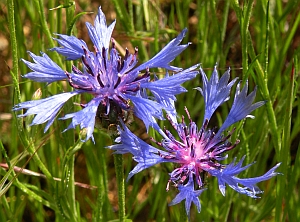 Cornflower Centaurea cyanus
© Teresa Farino
Cornflower Centaurea cyanus
© Teresa Farino
Teresa's last splendid picnic lunch had the setting it deserved, in the attractive gardens of El Convento, after which some of us flitted between flowerbeds, just like the butterflies we were trying to photograph. Not surprisingly, garden varieties of Dianthus barbatus (Sweet-William) and Hesperis matronalis (Dame's-violet) attracted the most insects, including Hummingbird Hawk-moths (Macroglossum stellatarum), Queen of Spain Fritillaries and a rather languid Cardinal (Argynnis pandora), whose image was captured beautifully by Liz.
After lunch we headed for the hills for the last time, this time for the magnificent two-tiered limestone buttresses of Peña Amaya. En route, we stopped briefly in the extensive arable fields to the south, finding Pisum sativum (Garden Pea) and the curious Vaccaria hispanica (Cow Basil), with its inflated calices, plus many of our old favourites: Ranunculus arvensis, Papaver argemone, Scandix pecten-veneris and S. australis. A splendid male Montagu's Harrier flew alongside the vehicles as we approached the village of Amaya.
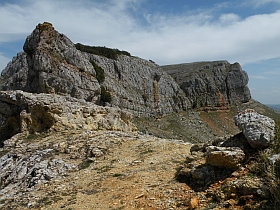 Peña Amaya
© Teresa Farino
Peña Amaya
© Teresa Farino
From Amaya we drove onward and upward to get within easy walking distance of the top of the buttress. The more agile members of the group made for the high crags, others took a scary peep over the edge of the precipice to the village below and some of us lingered amongst the pavement-like limestone slabs, where the greatest diversity of flowers was to be found. Here we encountered Ranunculus ollissiponensis, the clump-forming Dianthus pungens ssp. brachyanthus, Paronychia kapela ssp. kapela, with its white, papery bracts, an abundance of Arabis scabra and Draba dedeana, the delightful little Legousia hybrida (Venus's-looking-glass) and an abundance of the diminutive Senecio minutus. Annette and Shirley also located some splendid specimens of the rather foetid, Iberian endemic stork's-bill Erodium glandulosum in the limestone pavement, and once back at the vehicles, we found Asperugo procumbens (Madwort), with its distinctive seed capsules, on the edge of the car-park.
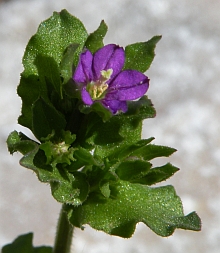 Venus's-looking-glass
Venus's-looking-glass
Legousia hybrida
© Teresa Farino
Our journey back to base took us through magnificent scenery, made all the more dramatic because the sun was setting, creating sharp contrasts between sculptured sunlit crags and black-shadowed cliff faces. We made one last stop in another small and seemingly quite undistinguished village - Rebolledo de La Torre - in the centre of which is a church whose portico is one of the most magnificent examples of Romanesque architecture in the province.
We returned to El Convento for a last jolly evening meal together, for which the chef had prepared a fine paella for us. It was tinged with regret, however, as we contemplated having to leave this extraordinary landscape, with its dramatic scenery and myriad places where botanical treasures were still flourishing.
20 May 2009 - Milagros (Bu) and Embalse de Pedrezuela (M)
An early start gave us a little time in hand as we headed back to Madrid, so we had time to stop for coffee in Milagros, where a quick examination of the car park turned up the ruderal crucifers Descurainia sophia (Flixweed) and Calepina irregularis (White Ball Mustard), as well as Matthiola fruticulosa (Sad Stock), Reseda phyteuma (Corn Mignonette) and Lithodora fruticosa (Shrubby Gromwell).
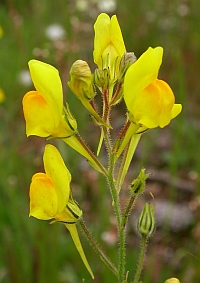 Linaria spartea
© Teresa Farino
Linaria spartea
© Teresa Farino
Once through the tunnel that traverses the Guadarrama at Somosierra, we turned west off the A1 at junction 50, to make one last foray in the dry Mediterranean vegetation near the Embalse de Pedrezuela. The fairly acid, sandy soils here supported shrubby Lavandula stoechas, Thymus mastichina (Round-headed Thyme) and Osyris alba (Osyris), between which flourished more colourful Lupinus angustifolius (Narrow-leaved Lupin), the delicate annual, yellow-flowered toadflax Linaria spartea, Campanula rapunculus (Rampion Bellflower), C. lusitanica and the lemon-yellow composite Andryala integrifolia.
Arthur found yet another mystery Agrostis, and Gerard collected a Stipa species taller than he was, which Arthur said was probably S. gigantea, and promptly added to his bulging suitcase full of specimens. Arthur has attended four of the five previous BSBI trips to Spain led by Teresa, from which he has provided her with herbarium specimens of no less than 167 taxa of rushes, grasses and sedges, with Eric Clement providing confirmation of the identification of critical or doubtful material. No doubt many more taxa were added during this most recent foray, and Teresa looks forward to receiving the latest batch in due course.
This report was written by Paul Bartlett, Liz Clark, Arthur Copping, Gerard Dirkse, John Edgington, Teresa Farino, Lynne Farrell, Annette Ford, Sue Helm, Sophie Hochstenbach, Martin and Clare Rand, Leslie Tucker and Shirley Watson, and was edited by Teresa Farino. It was previously published in BSBI News 112; 51-58 (September 2009).
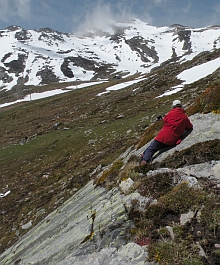 Lynne Farrell in intrepid mode at Alto Campóo
© Teresa Farino
Lynne Farrell in intrepid mode at Alto Campóo
© Teresa Farino
Botanical holidays in Spain and Portugal:
Natural History of the Picos de Europa and Páramos of Northern Castile
Wildlife of Almería - botanical holidays in Andalucia
A Feast of Flowers - botanical holidays in the Picos de Europa
Reports of other botanical trips in Spain and Portugal:
IWT Feast of Flowers in the Picos de Europa - Trip report 2009
BSBI Botanical Tour to Benasque - Trip Report 2008
BSBI Botanical Tour in the Sierra de Grazalema - Trip Report 2007
BSBI Botanical Tour in Western Portugal - Trip Report 2006
BSBI Botanical Tour to the Catalan Pyrenees - Trip Report 2005
BSBI Botanical Tour of the Picos de Europa - Trip Report 2004
Related information:
Read about Teresa Farino
Botany holidays in Spain & Portugal
|